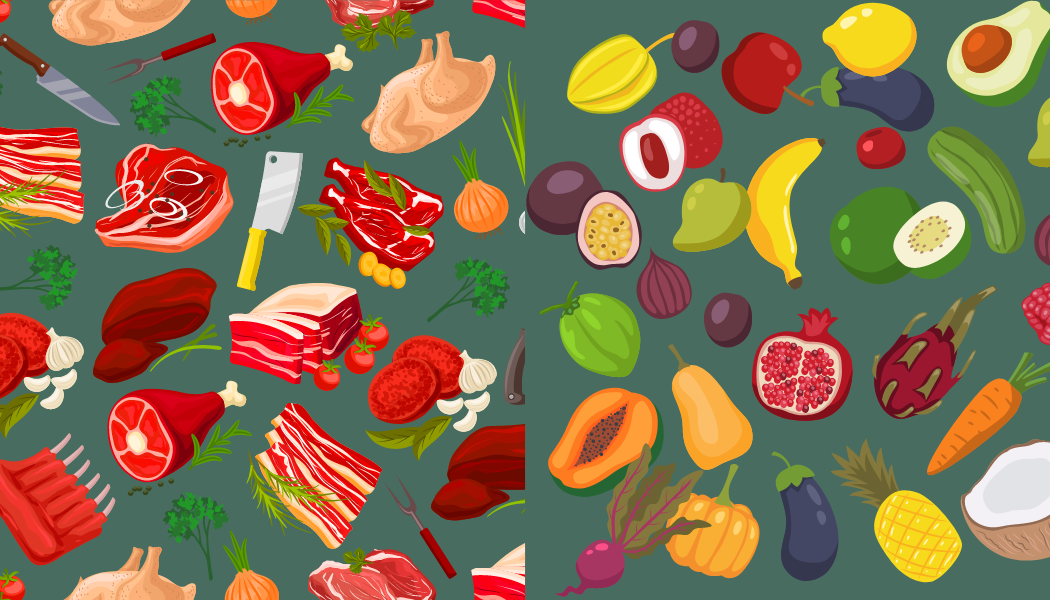The initial Google search…
Upon an initial Google search of the impact of veganism, you’ll primarily see positives. From an environmental perspective, most sources cite that a vegan diet requires less water, emits less greenhouse gasses, and requires less land to produce. From a health perspective, you’ll typically see impacts like weight loss, lower cholesterol, and lower risk for certain cardiovascular diseases and some cancers by eating a vegan diet. This seems like a win-win, right? Why don’t we globally implement vegan diets? Wouldn’t that lead to a healthier population and a healthier planet? Let’s dig into the data to better understand the true impact of diet on the environment and our health.
Environmental impacts: water usage
The first claim we will dig into is that there’s a significant reduction in water usage required to produce food for a vegan diet as compared to producing food for a carnivorous diet (i.e. animal products). This is a true statement, especially if we look at it from a surface level. The table below from this water calculator site compares typical protein sources for a vegan vs. carnivore diet. You will see that a vegan diet typically uses less water per serving. With this surface level view, you can argue a significant positive environmental impact of veganism.
| Food (serving size) | Water Footprint per Serving (gallons) |
| Beef (4 oz.) | 463 |
| Chicken (4 oz.) | 130 |
| Eggs, chicken (4 oz.) | 98 |
| Tofu (4 oz.) | 76 |
| Lentils (4 oz.) | 57 |
| Almonds (4 oz.) | 483 |
If we dig a little deeper, we find that agricultural water can be broken up into three different types. This is again summarized on the same water calculator site. Blue water is “the amount of surface water and groundwater required to produce an item.” Green water is “the amount of rainwater required to produce an item.” Lastly, gray water is “the amount of freshwater required to dilute the wastewater generated in manufacturing, in order to maintain water quality, as determined by state and local standards.” There are a lot of nuances to this topic because freshwater and rain water availability looks very different depending on where you live. If we look broadly at these definitions, we would want to minimize our blue and gray water (fresh water) usage, and maximize our green water (rain water) usage. Let’s take a look at these same protein sources again.
| Food (serving size) | Water Footprint per Serving (gallons) | Blue Water | Green Water | Gray Water |
| Beef (4 oz.) | 463 | 4% (19 gallons) | 94% (435 gallons) | 3% (14 gallons) |
| Chicken (4 oz.) | 130 | 7% (9 gallons) | 82% (107 gallons) | 11% (14 gallons) |
| Eggs, chicken (4 oz.) | 98 | 7% (7 gallons) | 79% (77 gallons) | 13% (13 gallons) |
| Tofu (4 oz.) | 76 | 3% (2 gallons) | 95% (72 gallons) | 2% (2 gallons) |
| Lentils (4 oz.) | 57 | 8% (5 gallons) | 74% (42 gallons) | 18% (10 gallons) |
| Almonds (4 oz.) | 483 | 24% (116 gallons) | 57% (275 gallons) | 19% (92 gallons) |
Let’s look at the combined freshwater usage (blue + gray in the above table). Tofu and lentils still beat out all our animal protein sources (4 and 15 gallons respectively). But you’ll see the animal protein sources are not that far behind (33 – beef, 23 – chicken, 20 – eggs). Almonds are in a league of their own in terms of significant freshwater usage (208 gallons).
Lastly, I want to focus on beef as it’s particularly highlighted as a “bad actor” from an environmental standpoint. The same source that provides average water footprints for various foods (see tables above) has published an article specifically comparing conventional beef (industrial and grain-fed) compared to pasture-raised beef (grass-fed). The overall water footprint of beef is not very different when comparing conventional to pasture-raised. However, when taking a closer look at blue, green, and gray water usage there is a substantial difference between the two. Specific numbers are not given as research assumptions vary and most research is globally focused. However, there is enough information to at least categorize small/medium/large impacts on each type of water between conventional and pasture-raised beef which is shown in the table below. As you can see, the type of beef you buy matters! Pasture-raised and grass-fed beef has the breakdown of water we want to see.
| Beef Type | Blue Water Rating | Green Water Rating | Gray Water Rating |
| Conventional | Medium-Large | Small-Medium | Large |
| Pasture-Raised | Small | Large | Small |
Environmental impacts: greenhouse gas emissions
Most recent sources agree that animal agriculture accounts for approximately 14-16% of global emissions. This is significant, but not the largest source of emissions. The majority of agricultural emissions consist of methane (from a cow’s digestion process and manure) and carbon dioxide (from removal of natural vegetation for use to grow animal products). Theoretically if one day the world stops eating meat, that means the 14-16% of greenhouse gas emissions goes away, right? Not necessarily. Most studies agree that removal of animals from the food system will decrease greenhouse gasses overall, but the real question is by how much? One study indicated a decrease in greenhouse gasses by 28% for the agricultural sector in the United States with the elimination of animal products, but a total decrease in greenhouse gasses for the United States of only 2.6%. A larger decrease wasn’t realized for many reasons, a few of which I’ll go into below. However, we must realize there is a lot of nuance with this topic. This is all based on simulations and studies that haven’t actually been implemented.
First, manure is a key fertilizer if collected and used properly in crop production. It’s a natural soil fertilizer which helps keep carbon in the soil (instead of the air, which causes global warming). Manure, in turn, produces more nutrient-dense food. Without manure as a natural fertilizer, more synthetic fertilizers are needed. This would cause additional greenhouse gas production among other potential issues.
Second, animals currently consume many by-products from food, biofuel, and fiber production that humans cannot consume. Without animals to consume these items, there will be a need to dispose of these by-products elsewhere which will cost additional greenhouse gas emissions.
We definitely cannot say that keeping meat in the food chain will resolve all of our problems. In fact, maybe it will continue exacerbating the current problems. However, in my opinion, I don’t think we can say removing meat from the food chain will resolve all of our problems either.
Environmental impacts: land usage
If animal products are completely removed from diets and the agricultural sector, overall food quantities will increase. One simulation study estimated a 23% increase in total food production if animal products were removed. The reason for this is that animal products make up a significant percentage of food that Americans consume and animal production typically requires significant land to fulfill the animal’s needs. If animal products were totally removed, at least part of the grazing land currently used for animals will need to be converted to farmland to produce other crops for consumption to fill the gap. Since so much more land would be available for crop production, this is where the overall food production increase comes from.
With the global population continuing to grow, food production must increase to account for this population growth. This can be seen as further justification to remove animal products from our diets, but there are a few important considerations before we make this decision. First, animal grazing lands are rarely ideal for producing crops. This means if we convert grazing lands to farmland, we are likely to have significantly lower yields than with traditional farmland. Second, the conversion of grazing land to farmland will certainly cost us further greenhouse gas emissions due to the removal of natural vegetation. Third, the likely crops that would be planted in these converted farmlands would be corn and soy. Corn and soy have significantly different nutritional profiles compared to the animal products they would be replacing. Let’s move on to discuss the health impacts of various diet choices where we will learn more about the different nutritional profiles and their impacts.
Health impacts: risk of developing disease
Plenty of research articles exist claiming the health benefits of veganism. There are studies showing that plant-based diets help with weight loss, reduce risks of some cardiovascular diseases and cancers, and can also help with lowering cholesterol. One of the caveats mentioned in almost all of these studies is that people who follow plant-based diets in general have a lower body mass index (BMI) and exercise more frequently compared to people who follow carnivore diets. So yes, maybe a vegan diet helps reduce the risk of developing diseases. However, there are confounding factors like BMI and exercise that could also contribute significantly. I do believe there are a lot of important compounds in plants that are beneficial in reducing the risk for cardiovascular disease and cancer and I think it’s important to eat a wide variety of fruits and vegetables. But does this really mean you should only eat plants to obtain these benefits? Or can you still introduce these compounds while consuming a moderate quantity of meat? I personally think there can be a place for the right types of animal products alongside a diverse number of fruits and vegetables.
Speaking of the right types of animal products, let’s talk about the health differences of conventional beef to pasture-raised beef. The ratio of omega-6 to omega-3 fatty acids is important as it is likely to influence risk of cardiovascular and other diseases. Conventional beef has a significantly higher amount of omega-6 fatty acids. This is because of the use of more grain-based feed. While we need omega-6 fatty acids in the right ratio, too much can lead to poor health. This is likely one of the reasons eating meat is associated with cardiovascular diseases. Pasture-raised beef, on the other hand, has a significantly higher amount of omega-3 fatty acids. These are the “better” fatty acids also found in things like avocados and olive oil. Your risk of cardiovascular disease could also be changed by the type of beef you choose to consume.
Health impacts: nutrient deficiencies
One of the primary concerns of a vegan diet is related to nutrient deficiencies. There are studies indicating that vegans typically have a lower protein intake and there is a risk for certain nutrient deficiencies like Vitamin B12, Iron, Zinc and important omega-3 fatty acids like EPA and DHA. However, we can’t look at vegan nutrient deficiencies in a vacuum. This study shows that it’s also likely for people eating animal products to have nutrient deficiencies. The table below from this study shows a summary of nutrient deficiencies for each type of diet.
| Dietary Pattern | Nutrients at Risk of Inadequacy | Nutrients of Favorably High Intake |
| Vegan Diet | EPA, DHA (fatty acids), Vitamins B12, D, Calcium, Iodine, Iron, Zinc | Fiber, PUFA, ALA, Vitamins B1, B6, C, E, Folate, Magnesium |
| Carnivore or Omnivore Diet | Fiber, PUFA, ALA, Vitamins D, E, Folate, Calcium, Magnesium | Protein, Niacin, Vitamin B12, Zinc |
Looking at the nutrient inadequacies of each diet, you’ll see that these are mostly filled by the opposite dietary pattern. Fiber, PUFA (polyunsaturated fatty acid) and ALA (alpha linoleic acid) are likely to be inadequate in meat-eaters, but are of favorably high intake for vegans. Vitamins B12 and Zinc are likely to be inadequate in vegans, but are of favorably high intake for meat-eaters.
Another consideration when looking at nutrient deficiencies for various dietary patterns is the bioavailability and absorption for various nutrients. For instance, iron and zinc are much less bioavailable for the body to absorb from plant-based foods compared to meat. Therefore, to obtain adequate levels of these nutrients, vegans must eat a larger quantity of foods with these nutrients to obtain the same level as meat-eaters.
I think this study said it best “It is entirely possible to meet the nutrient requirements of individual humans with carefully crafted, unsupplemented plant-based rations, but this can be a challenge to achieve in practice for an entire population.” If you feel your best when eating vegan food and you’re comfortable with your nutrient levels, that’s great! But let’s be cautious about pushing the same dietary choices onto an entire global population that may not have the same ability. And if you feel your best incorporating animal products, that’s great! But let’s not assume that only vegans can have nutrient deficiencies. If we are not eating plants in addition to animal products, some nutrient deficiencies are likely to exist.



Health impacts: protein and caloric intake
The last consideration is around protein and caloric intake. If you have high activity levels or are focusing on building muscle through strength training, you probably have high protein needs. Every person is different, has different macronutrient requirements, and it takes time to figure out what your body responds best to. If you are trying to build lean muscle through strength training, the most general guidance is to eat 1 gram of protein per pound of body weight. If you weigh 130 pounds, that means you should be targeting 130 grams of protein per day.
We can all agree that total protein content is higher per serving in most animal products compared to vegan protein options (excluding protein powders). This means the amount of calories you need to consume to get an equivalent amount of protein from a vegan diet compared to a meat-eating diet is vastly different. Let’s compare a few examples.
| Food (serving) | Calories per serving (kcal) | Protein per serving (g) |
| Tofu (4 oz.) | 50 | 5 |
| Black Beans (1 cup) | 220 | 15 |
| Beef (4 oz.) | 190 | 35 |
| Chicken (4 oz.) | 200 | 33 |
This means to get the same amount of protein as beef or chicken, you’d need to eat 28 oz. of tofu (350 calories) or 2.5 cups of black beans (550 calories), which is about two to three times the amount of calories as animal products.
As we consider protein and caloric intake needs and if a vegan diet is healthy long-term, it’s also important to realize that as humans age, protein requirements to maintain muscle mass increase while calorie needs typically decrease. Maintaining muscle mass as we age is one of the best things we can do for our health. As we can see with the information above, it will be increasingly difficult to achieve the increased protein and decreased caloric needs with a fully plant-based diet.
Your responsible choice doesn’t have to look the same as mine.
We all want an answer to the question: Is veganism the most sustainable diet? As always, it depends. You can see there is a lot of contradiction in the evidence provided by various sources. I know it can be overwhelming to try to figure out what the “right” thing to do is. I think the evidence shows there is no 100% right answer. There are significant risks to the environment and nutrition of the global population by converting the entire world to veganism. There are also significant risks to the environment and nutrition of the global population by continuing the current path and not making any changes to the food we consume. I’ll close this post out by giving some practical tips for how you can make the most responsible choice for you and your family.
- If a plant-based diet interests you, try it out! Take notes on how you’re feeling compared to your typical diet and see if it’s something that might be sustainable.
- If you want to implement a plant-based diet long-term, be aware of the possible nutrient deficiencies noted above and work with your doctor to address any concerns.
- If a meat-based diet is more your thing, be aware of the type of meat you’re buying and if your budget allows, try to buy more pasture-raised animal products to reduce your impact on the environment.
- If you want to implement a meat-based diet long-term, be aware of the possible nutrient deficiencies noted above and work with your doctor to address any concerns. Adding more and different plant foods to your diet may help with the normal nutrient deficiencies seen in meat-based diets.
- Whichever diet you choose, focus on real foods that are organic and pasture-raised when possible. Avoid pre-packaged foods which are typically less nutritious and can have unnecessary ingredients, if practical for your household.
- Advocate for people being able to choose the diet that works best for them. There is no singular choice that will fix our current environmental state, and it’s inaccurate to assume this is true. If this topic is something that interests you and you are passionate about, it may be beneficial to talk to your senators and representatives as environmental laws are being discussed that may have an impact on the population’s ability to choose their type of eating habits for themselves.
SOURCES:
- https://www.watercalculator.org/water-footprint-of-food-guide/
- https://www.watercalculator.org/footprint/water-footprint-beef-industrial-pasture/
- https://www.pnas.org/doi/10.1073/pnas.1707322114
- https://www.ncbi.nlm.nih.gov/pmc/articles/PMC8746448/
- https://www.sciencedirect.com/science/article/abs/pii/S0753332202002536?via%3Dihub
- https://www.ncbi.nlm.nih.gov/pmc/articles/PMC2846864/








